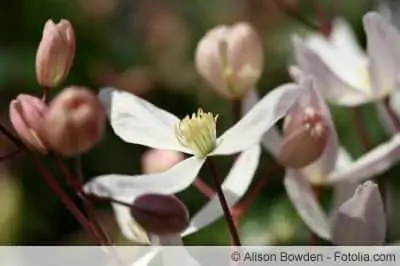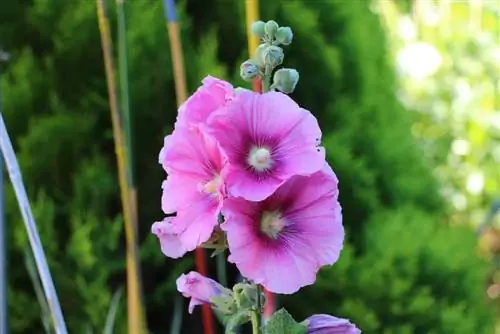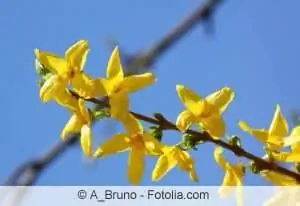- Author admin [email protected].
- Public 2023-12-17 03:39.
- Last modified 2025-06-01 06:48.
The clematis from the buttercup family grows as a herbaceous climbing plant, shrub or sub-shrub as well as medium or strong growing lianas, but above all woody. It is divided into different groups, each of which differs in growth rate and flowering time, with the early flowering ones being particularly strong. Clematis hybrids, on the other hand, produce the largest flowers. The most important part of care is pruning.
Good reasons for pruning
There are many good reasons for regular pruning of clematis, as it brings some significant benefits to this attractive and versatile plant. So every cut has its justification, provided it is done at the best time and in the right way.
- Opening cut, provides more light inside the plant
- Shoots inside the plant can develop optimally and branch better
- Affects both existing and newly forming shoots
- This cut is particularly recommended for early flowering varieties
- Regular removal of old shoots results in the formation of new ones
- This form of pruning is recommended for all clematis varieties
- Rejuvenation pruning is used to rejuvenate plants that have been neglected for a long time
- Radical pruning is required for rejuvenation, approximately every four to five years
- This cut is advisable on old and already bare plants of all varieties
Removing wilted flowers makes sense, especially for clematis that bloom more often, because this cut is usually followed by a second, even more intense bloom. When and how exactly a clematis should be trimmed depends largely on the flowering time. This is exactly what the plant divides into different cutting groups.
Cutting group I - early varieties
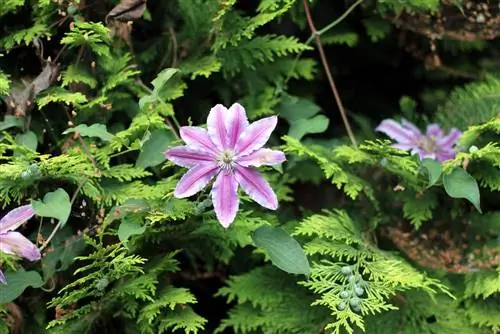
Cutting group I includes varieties that bloom in spring. Some show their magnificent flowers as early as April, but most appear in May. The buds of these clematis are formed or laid on the previous year's shoots in autumn, so that they are already in full bloom in spring. For this reason, pruning in autumn would not make sense, because then all the fresh buds would be cut off and the flowers would not bloom. Clematis in pruning group I include robust and vital wild species such as the Alpine clematis (C. Alpina) and the anemone clematis (C. Montana), which do not require severe pruning. However, an occasional thinning cut is still useful.
Cutting instructions
As already mentioned, with a clematis in cutting group I it is sufficient to just thin it out or shorten it every year if it has become too large. The best time for this is after flowering, around June/July. This means the plants can form new flower shoots in peace until the next season.
- After flowering, cut out everything that is wilted, dead and dead
- In addition, remove any seed heads that form
- You unnecessarily deprive the plant of strength
- Short side shoots that are too long as well
- How to get the clematis back into shape
- Rejuvenate old and already bare clematis in this cutting group
- Rejuvenation cutting is also recommended here every four to five years
- Best time for this cut is in late autumn or November/December
You can even put the plant on the stick by topping it about ten to fifteen centimeters above the ground. After such a cut, the plant initially uses all its energy to form new shoots and neglects flowering, so you have to go without flowers for a year. It is best to proceed with a rejuvenation cut in two steps. First, cut back half of the shoots to just above the ground. In the second step or next year, you proceed with the other half in the same way.
Pruning group III - late varieties
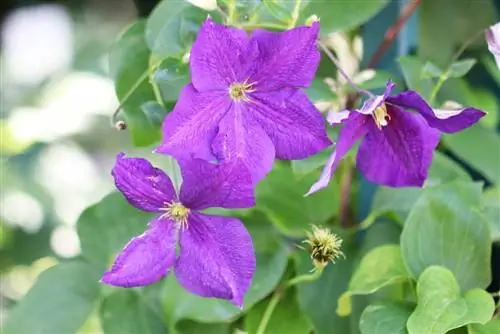
If the clematis only blooms in the second half of June and July, it belongs to cutting group III, because this includes all late-blooming or most summer-blooming varieties. They have the ability to sprout heavily and shoot up every year, which usually requires more pruning.
Without pruning, they can easily grow up to 500 cm in height. In contrast to the other cutting groups, the new shoots here are not formed on the old wood, but directly from the roots. This cutting group includes, among others, our native clematis (C. Vitalba), all once-flowering hybrids (C. Jackmannii) and the large group of perennial clematis.
Cutting instructions
- The best time to prune is in late autumn, around November/December
- If the right time was missed, pruning is still possible in early spring
- Use scissors preferably between February and March
- The shoots of these varieties are formed from the roots
- Accordingly, a radical pruning is possible without any problem
- Cut the clematis back to 20-50 cm above the ground
- At the same time, cut off dead, dry and diseased wood directly at the base
- When cutting in spring, pay attention to the new shoots
- New shoots could be accidentally cut when cutting
Tip:
If you avoid such radical cuts with these varieties, these plants can age relatively quickly. Then it takes significantly more time and work to help them regain their shine.
Build-up cut independent of the cut group
A so-called pruning in the year of planting is recommended for all varieties, regardless of when they bloom or which pruning group they belong to. This cut is intended to train the clematis into a well-branched plant. It then sprouts stronger and more densely branched the following year. The formation of bald spots is counteracted. The build-up cut can be carried out in November/December just like the normal pruning. In doing so, all shoots orTendrils grow back to a height of 20 or 30 centimeters. However, for some hybrids and wild species, flowering in spring will have to be avoided next year. But later they bloom more beautifully and lushly.
A few tips at the end
Regular pruning is almost always recommended for this plant, even if it is limited to the bare minimum for the early-flowering varieties. Be it to let them grow back more compact, denser and better branched, to limit their height or to bring older, no longer so beautiful specimens back to life. However, before you reach for the scissors, you should make sure what kind of variety or cutting group it is, or when it blooms.
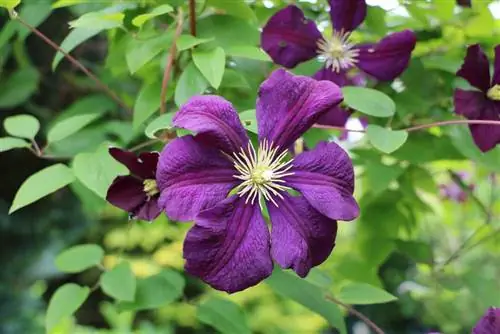
Both the cutting time and the cutting procedure depend on this. In general, summer-flowering varieties require more vigorous pruning, while wild varieties and large-flowered hybrids should be pruned more cautiously. Incidentally, the clematis produces flowers regardless of the cut, only from the third year onwards, because then it is essentially an adult.



